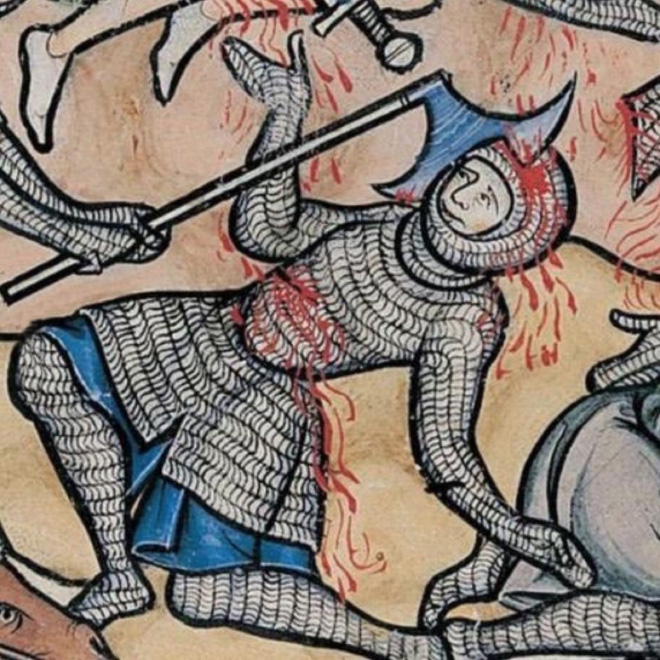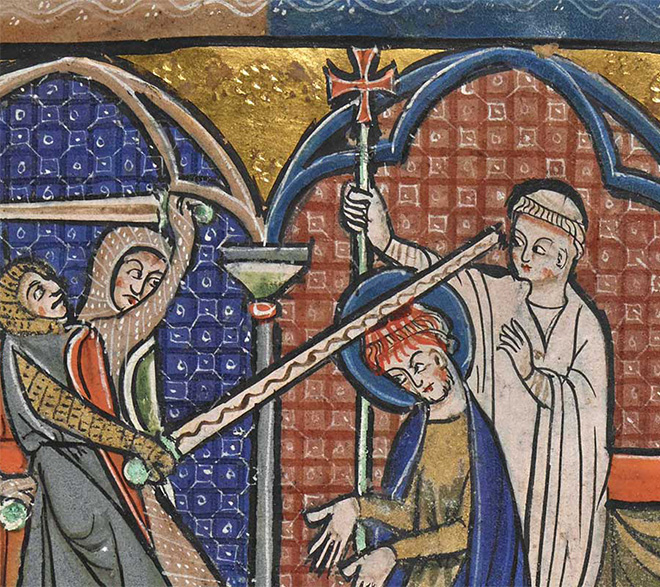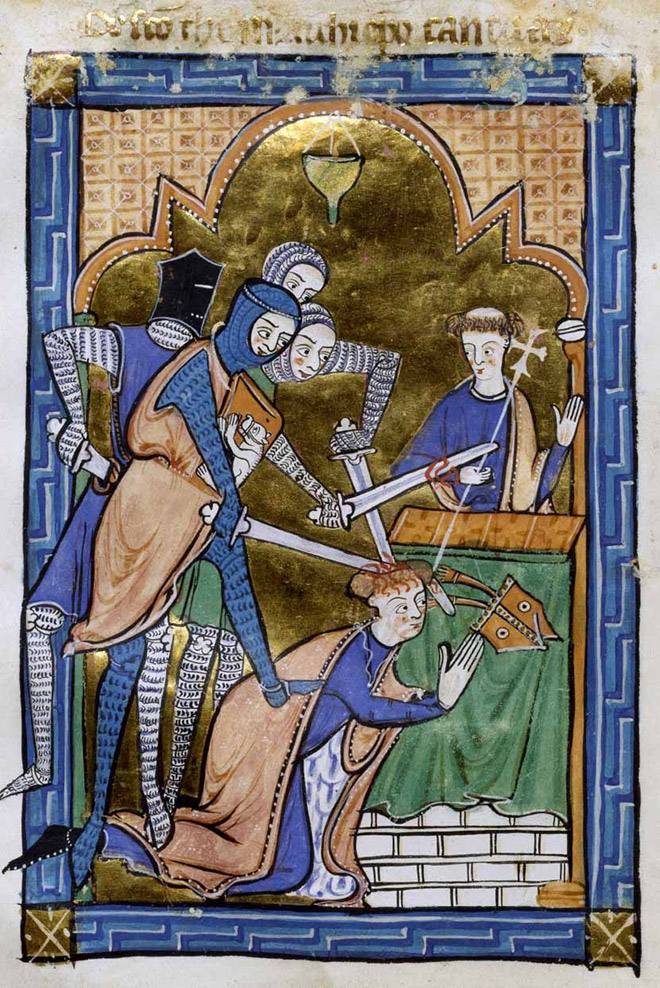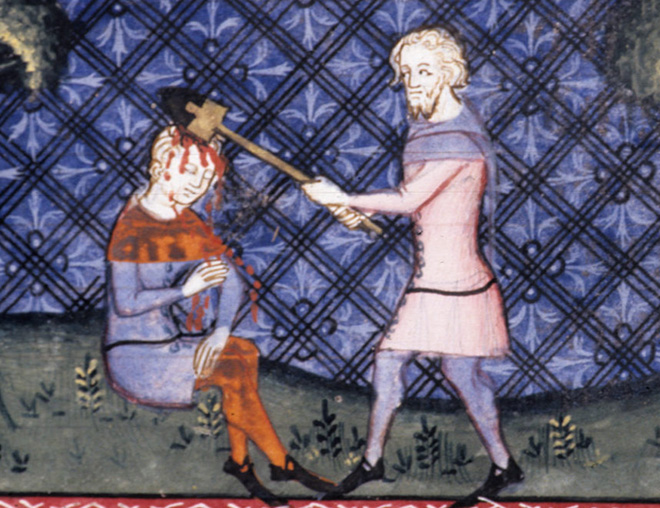Medieval manuscripts were the imageboards of their day, full of murderous illustrations, however for some strange reason many people look as if they were bored with life anyway and their killer did them a service all while enjoying it himself. Scroll down to see the funniest examples of medieval art where people are getting killed but just don’t give a damn.




















If you enjoyed this gallery, you will also like Medieval Art of Cats Licking Their Butts, Auto Mechanics Recreate Renaissance Paintings, and Ugly Medieval Paintings of Cats.




Man-up – thet are only flesh wounds!
‘Tis but a scratch
– The Black Knight
You really need to brush up on your English. Who’re is not a contraction in the English language! Cringed when I read the title!
This is an old repeat post!
Yes, it is a contraction in the English language!
The getting the stick in the eye isn’t getting murdered, he’s having cataract surgery. It was one of the few surgeries medieval physicians knew how to do.
https://dictionary.cambridge.org/us/dictionary/english/who-re
Who’re is a contraction.It means prostitute.
Please give some information on the pictures.
Pretty sure some of these images are of doctors treating patients.
Who’re is a contraction in the English language. https://www.dictionary.com/browse/who-re
The media in its sensationalist technique of omitting important info…:-) those are saints (like it or not) and were supposed to be infused with their martir mentality .:-)
The murderers aren’t too amused either
You are misinterpreting the images. They are part of Christian iconography and not meant to show a moment in time like a photograph but a story, very much like Egyptian hieroglyphs. The faithful who would see these illustrations would know how to read the symbols. The martyrs are painted with serene expressions because they’re believed to have surpassed the pain of martrydom to be in heaven. Inform yourself!
Check the Cambridge Dictionary. Who’re is indeed a contraction.
Why ppl gotta come here, to a humor site, and complain about grammar and trivia about the origin of the pictures. It’s posted to laugh at people with a sword thru their head and they give zero f’s about it. Look, LOL, move on.
Our insane ancestors.
There aren’t a list of “approved” contractions–contracting words is a system of combining sounds. “Who’re” works. You’re not supposed to use contractions in publications, but considering this is a bad humor blog, who cares?
It’s called martyrdom, you ignoramuses.
Dude with the monk haircut be like, what do you mean, does that hurt?… I have a knife WHERE?
I second that. Who’re is indeed a contraction in the English language. It is a contraction of “who” and “are”.
While contractions are whstever,its not a doctral disertation, simply laughing snd not caring about the intention and reason for the psintings is a terrible idea. First, knoledge is always power, ignorance is evil.Next, knowing the historical cotext doest diminish the humour. Finally, if humour is the goal ,knowledge like this allows for a deeper more apreciative joke. Inside knowledgable jokes that take clver thought to get tend to be funnier thanpoooop.
Why you gotta be such a windbagggggg?
Alright now, grammar freaks; who’re we to judge? :P
jeez, people on the internet…do you have to carp about EVERYTHING?!? Oh no…you got ME doing it!!!
Wow everyone here commenting on people being ignorant and not understanding martyrdom, I think you need to ease up a bit. I understand the concept, I myself am a Christian. That doesn’t make the images any less humorous in my eyes. It’s the style of painting as well. Rendering of the human form was still in it’s early stages. I certainly meant no disrespect when I chuckled at these paintings.
Simple, people were more stoic
Even funnier than the images are the SERIOUS comments above. I´d like to spend a whole evening with those gents, Ideally with them insulting me in an older form of the English language.
Hebrews 11:35 Women received their dead—they were raised to life again. Some men were tortured, not accepting release, so that they might gain a better resurrection, 36 and others experienced mockings and scourgings, as well as bonds and imprisonment. 37 They were stoned,[k] they were sawed in two, they died by the sword, they wandered about in sheepskins, in goatskins, destitute, afflicted, and mistreated. 38 The world was not worthy of them. They wandered in deserts and on mountains, hiding in caves and holes in the ground.
39 All these were approved through their faith, but they did not receive what was promised, 40 since God had provided something better for us, so that they would not be made perfect without us.
Jeez, Diana. Buzzkill.
If you know about coding of culture and race in medieval art, much of what you see here are coding of Jews and Muslims. This is a lot of Christian/crusader murder of oriental “others”. Orientalist prejudice is very old in the west and one of the three pillars of white supremacy. The fact that Jews and Muslims are smiling while being shown murdered tells you a lot about the Christian coated euro western mind. So does the fact that y’all didn’t catch that this was a chunk of not so funny historically brutal racist art.
Most of them are depicting the death of Becket i think. i was hoping to see in the comments if i could find out the story behind the woman with sword through the neck, but alas, the comments here are….i’ll say ‘less than knowledgeable.’
I understand the iconography.
I’m a student and collector.
However:
We need a calendar for this!
What a scream.
Some of these are not people dying, but receiving medical treatment. Some of them, as others have pointed out, are depictions of saints in glory, who are not affected by the pains of death. Pace our friend of Nov. 23, I don’t believe a single one of these shows Jews or Muslims being killed, though some of them, I think, show Jews in battle against the pagan tribes of Palestine. Some of them do not show happy faces at all; the eyebrows rise toward the middle, a conventional sign of sorrow and distress. The rest, I think, are sheer debility and routine.
All they thought was they will go to paradise.
Quite amusing.
Is there a way you could add some minimal identifying info on the images.
I did some image research and didn’t find most of them previously published online.
At least five of these depict the murder of Thomas Beckett…
Thomas Becket is totally over represented here
The “ME_DIEVEL’s” were a blase lot.
As usual the comments are more Sad and useless!
Thanks for a hillarious post. It made me LOL.
I think these are images of St Lucia (St Lucy), St Peter of Vernona (Peter the Martyr) and the murder of Thomas Beckett. As others have said, these images are coded. The paintings tell a story. Peter has a clever in his head, because that’s how he died. Assassins bashed him in the head with an axe. Same with Lucy. They wanted to force her into prostitution and she resisted so they stabbed her with a sword in the neck because as much as they tried to pick her up, she could not be moved (literally. It was a miracle). That’s how we can identify them. They look serene because they’re Saints and already dead. A bit like a ghost who looks like they already died.
Who’re you to tell us how to talk English?
Early form of the “this is fine” meme
They show how normally the victim looked like and how was killed.
they were like :”yeah whatever~~”
Kneeling man in Archbishop’s clothes having brains stirred up/head split open by three knights = Thomas Becket.
Woman with sword through neck = Lucia of Syracuse.
Fat crowned man being stabbed in the gut = Eglon, King of Moab + Ehud, doing the stabbing.
Fun stories accompany all of them, so google away.
The medical procedures are trepanning (man having a cross shape sliced, rather than hacked, into his head) and cataract removal (man having a scalpel applied to his eye).
Interestingly, a medieval sword fighting technique that not many people know about, as it’s rarely shown in movies, is also shown in one of the images: wielding the sword by the blade and striking an enemy with the pommel (the round bit on the end of the hilt). This was generally more effective against armour than using the sword the ‘right’ way round.
If there are any others people want identified respond by mentioning my name in a comment.
I think there is a better explanation of that. My theory – the artists did not know how to draw the expression. Only expression they knew is the happy faces. Look at the faces of the killers. They were smiling as well.
Use who’re in a sentence. contraction. Who’re is defined as the contraction of “who are.” An example is: Who’re the people at the front door?
I think because the times in Medieval, Christians that take a mass were killed by soldiers.
When your DM runs a shitty game.